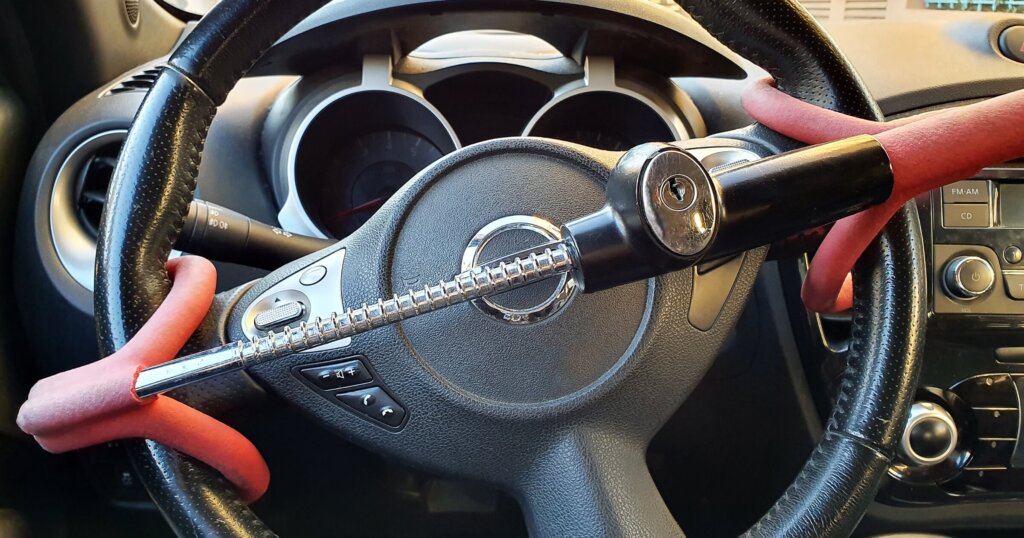Construction theft is a growing problem, and crews are paying the price. From excavators to generators, job site equipment is a hot target, and when it disappears, it throws entire projects off track. Anti-theft devices are one of the smartest investments you can make for your fleet. In this article, we’ll break down the most effective anti-theft options, explain why they matter, and help you decide which ones are right for your job site.
Quick look
- Equipment theft costs the construction industry millions each year, making jobsite security a must.
- Mechanical devices like steering locks and fuel shutoffs offer simple but effective theft prevention.
- Physical tools like battery enclosures and storage cages protect high-target components and gear.
- GPS tracking, geofencing, and remote immobilizers add smart, real-time control.
- Combining multiple device types gives your fleet stronger protection and faster recovery options.
Why anti-theft devices matter for heavy equipment
Heavy equipment theft costs the construction industry up to $1 billion a year, according to the National Equipment Register (NER). It’s not just the cost of the machine itself. The lost productivity, downtime, and replacement delays make things far worse than most contractors would expect. And because most construction gear doesn’t have standard licensing like vehicles, recovery rates are low. Only about 20% of stolen equipment is ever recovered.
Thieves target construction sites because they’re often unsecured after hours. Remote locations, inconsistent surveillance, and high resale value make equipment an easy target. It doesn’t take much for a thief to load up a skid steer, drive off with a backhoe, or siphon fuel from tanks. That’s why having anti-theft devices in place is a valuable tool to act as a deterrent.
Insurance can help, but it doesn’t cover the lost time, missed deadlines, or stress. And recovery efforts rarely make up for the loss. The best move is prevention. Installing security tools tailored to your gear gives you peace of mind and shows crews, clients, and insurance providers that you’re serious about job site security.
Mechanical anti-theft devices
Mechanical devices are often the first line of defense. They’re simple, physical barriers that make it harder for someone to drive off with your equipment. While they don’t alert you in real-time, they’re visible deterrents that slow thieves down and make them think twice.
Steering wheel and tire locks

Steering wheel lock for security. Photo via Shutterstock.
These are some of the most basic tools, but they still get the job done. Steering wheel locks clamp onto the wheel and prevent it from turning. Tire locks (also known as wheel boots) immobilize the tire entirely, making it impossible to drive the machine without removing the device.
They’re best used on smaller vehicles like loaders, trucks, or utility vehicles parked overnight. They’re affordable and easy to install, and they offer an obvious visual deterrent. A thief looking for a quick score is more likely to move on when they see a boot on a backhoe.
Hydraulic lockout devices
Hydraulic lockouts physically disable a machine’s hydraulic system when not in use. These locks prevent the operation of lift arms, buckets, or other attachments by blocking the flow of hydraulic fluid.
They’re especially useful for machines like excavators, mobile cranes, and lifts. Installation usually involves locking out valves or using custom-built lock boxes on control panels. They’re tamper-resistant, hard to bypass, and effective at shutting things down without damaging the equipment.
Ignition and fuel kill switches
Kill switches disable the machine’s ignition or fuel supply so it can’t start without disengaging the system. These devices are often hidden or disguised, which means even if a thief gets inside the cab, they won’t be able to figure out how to get the machine running.
Some models cut off electrical access to the starter. Others shut off the fuel line completely. Either way, it turns a quick grab-and-go into a frustrating puzzle. They’re ideal for high-value equipment and can be paired with GPS systems for even more protection.
Physical anti-theft devices
These devices focus on restricting access or disabling operation through reinforced, tamper-resistant hardware.
Lockable battery and engine enclosures
Thieves often target batteries and other easily accessible components. Lockable covers or enclosures can keep your critical parts secure. These cages or housings are made from heavy-duty steel and require special tools to open. In many cases, they prevent both theft and vandalism. They’re ideal for fleets left unattended in remote areas.
Enclosed job site storage cages
This is a broader security solution that protects small and midsize equipment. Welded wire or steel storage cages can be placed on job sites and locked up overnight. They’re especially effective for preventing theft of portable generators, compact tools, or smaller machinery attachments. Cages can be anchored to the ground for added security. They’re more costly up front, but pay for themselves in peace of mind.
Electronic anti-theft devices
Mechanical locks are a great starting point, but electronic devices take security up a notch. These systems allow you to monitor, track, and control your machines from a distance, giving you a better chance at recovery and deterrence.
GPS tracking systems

Aerial view of autonomous truck with GPS tracking. Photo via Shutterstock.
GPS trackers provide real-time location data for your equipment. They’re discreet, reliable, and becoming more popular with contractors who want to keep eyes on their fleet at all times. Many systems offer geolocation with accuracy down to a few meters. If something gets moved off-site or stolen, you can immediately alert law enforcement with exact coordinates. Some GPS units run off solar power or long-life batteries, making them ideal for remote or rugged areas.
Beyond theft prevention, GPS tracking can also help with logistics by tracking mileage, usage, and idle time. But its biggest strength is giving you a fighting chance to recover what’s yours.
Geofencing and motion alerts
Geofencing takes GPS tracking a step further. With this tool, you can set virtual boundaries around your site, storage yard, and even your entire fleet of machines. If a machine crosses that boundary, you get a real-time alert.
Some systems also include motion detection, sending push notifications if someone tampers with the equipment after hours. It’s a low-effort way to keep tabs on high-value gear while you sleep.
These systems are best used with machines that stay parked in one place overnight, like bulldozers, pavers, and tower cranes. You can program the alerts to contact you, your site manager, or even your security company.
Remote immobilizers
This tech lets you disable your equipment with the tap of a button. Remote immobilizers connect to your machine’s ignition or fuel system and allow you to shut it down via smartphone or computer. If a theft is in progress—or if you get an alert from a motion sensor—you can stop the equipment before it leaves the property. Some systems allow for restarting only once a passcode is entered, adding an extra layer of control.
They’re more expensive than other options, but they’re incredibly effective, especially when paired with GPS tracking. A thief might get in and start the machine, but they won’t get far.
Smart key access systems
Instead of using traditional keys (which are easy to duplicate), smart key systems restrict access based on individual authorization. Each operator gets a unique key fob or PIN, and usage is logged digitally.
These systems not only prevent unauthorized use but also help with tracking operator hours and machine usage.
Equipment ID and asset tagging systems
This includes etched serial numbers, RFID tags, or tamper-proof labels placed on equipment. While this won’t stop theft, it makes resale harder for criminals and improves recovery chances.
Some systems integrate with databases like the National Equipment Register, making it easier for police to identify stolen property.
Site surveillance with AI alerts
Surveillance isn’t new, but AI-enabled camera systems can now distinguish between human and vehicle movement, reducing false alarms. Some systems can trigger spotlights or loudspeakers when motion is detected, which often scares off trespassers before they touch the equipment.
Alarm systems with vibration detection
Unlike traditional motion sensors, these alarms detect vibrations and sudden movements, like someone tampering with a lock or starting a machine. They can be mounted directly on the equipment or inside a locked storage container.
How to choose the right anti-theft device for your fleet
Not every device is a good fit for every job site. Some crews may need high-tech tracking, while others just want basic deterrents. Choosing the right tool comes down to three main factors:
- Your budget
- The type of equipment you’re securing
- How high your risk of theft is
Start by assessing the value of the gear. Are you protecting a $10,000 trailer or a $150,000 excavator? The more expensive the equipment, the more you should invest in its protection. GPS trackers and remote immobilizers might be overkill for small handheld tools, but they’re worth it for machines that anchor your project.
Then consider your location and how often the equipment is left unattended. Remote sites, unsecured yards, and public-access projects are all higher-risk areas. If your gear sits in the open overnight or on weekends, you’ll want stronger protection than just a steering lock.
Finally, think about how many pieces of equipment you’re managing. If you’ve got a large fleet, choose systems that scale well, like centralized tracking dashboards, mobile alerts, and flexible installation options. Some brands offer subscription models for GPS and alert services, which can be budget-friendly across multiple machines.
The right combination might be layered: a tire boot, a GPS tracker, and a kill switch working together. This redundancy gives you better odds of catching any attempted theft.
Final thoughts
Construction equipment isn’t cheap. Letting it sit unsecured on the job site is an open invitation to thieves. But mechanical locks, GPS systems, kill switches, and other anti-theft devices are giving crews the upper hand.
Whether you run a small crew or manage a statewide fleet, it’s worth putting protections in place. Even basic gear can keep your machines out of the wrong hands and your project on schedule.
Want more smart ideas for protecting your crew and your equipment? Subscribe to our newsletter and get the latest straight to your inbox.




1 comment
Joshua Deadrick
Hello,
We’ve just jumped into the aerial lift industry to help reduce theft of scissor lift and boom lift equipment. With so many massive construction projects going on and a huge influx of construction workers on these sites. A Box Thing is set in motion to help deter individuals from using equipment that doesn’t belong to them.
Sales have started to generate and we’re striving to send this new product all throughout the market.
Built by a contractor for contractors